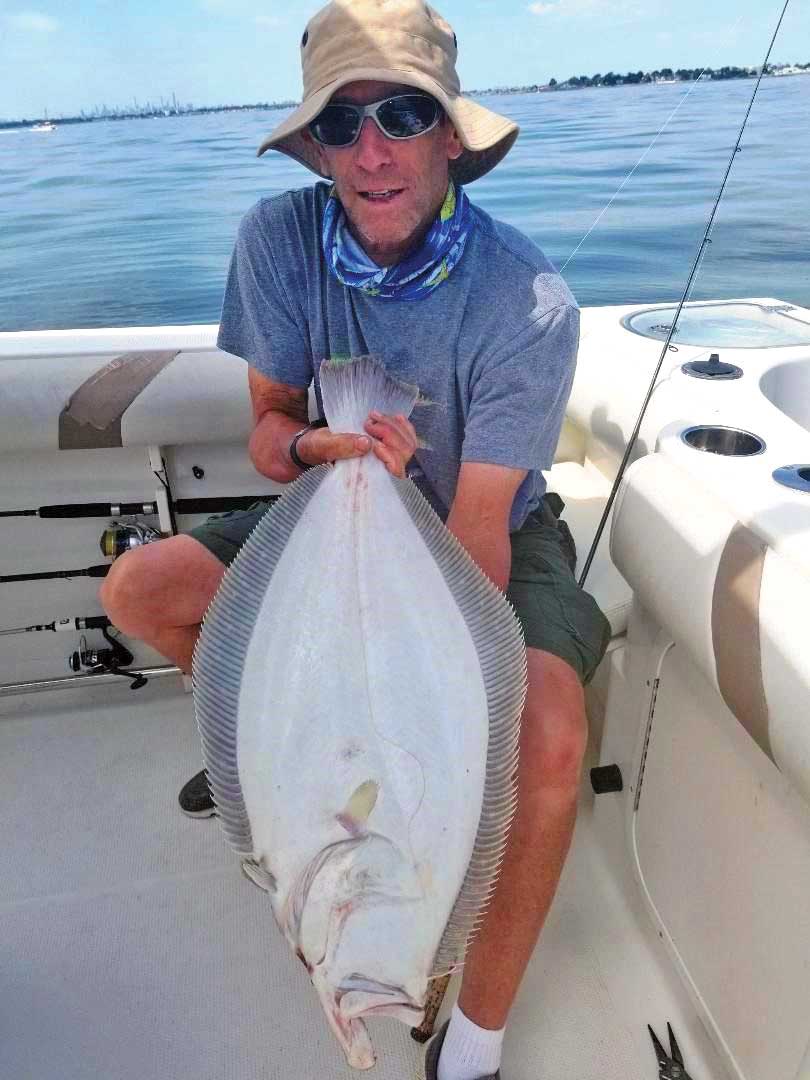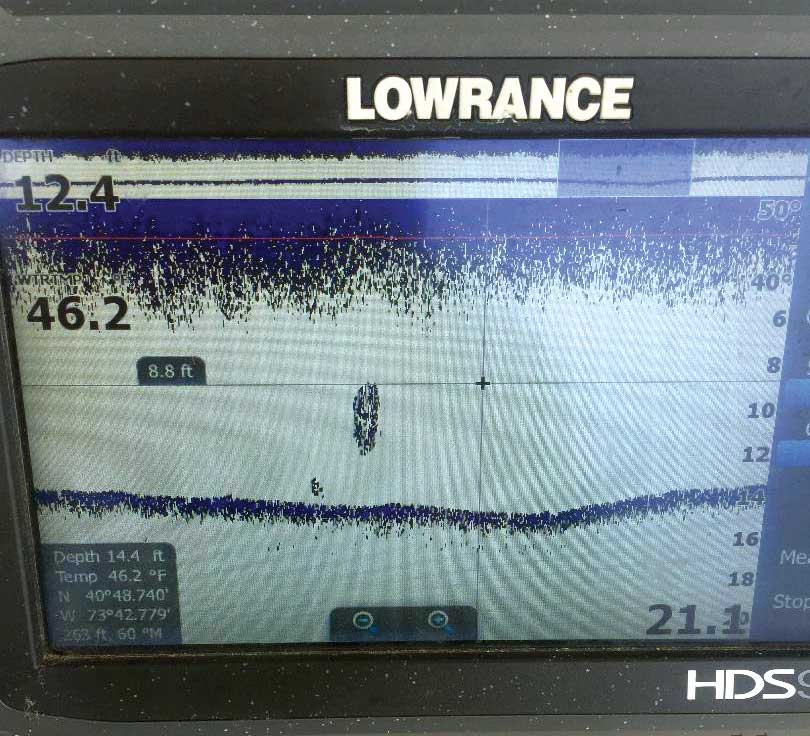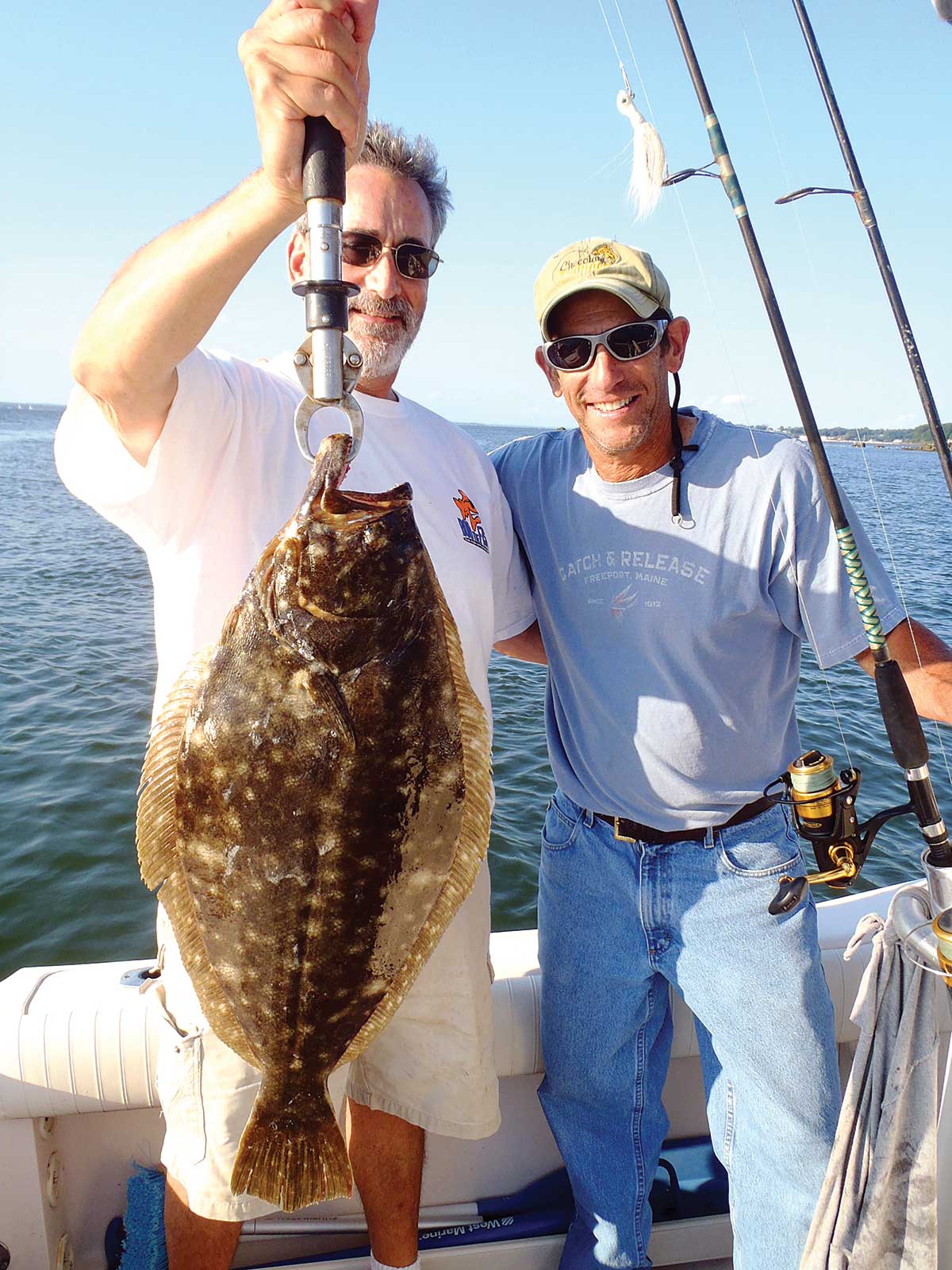Eventually our efforts lead to a distribution pattern of slopes, currents, and bait balls that allowed us to enjoy some good trips.
Where was the bait? It was a key question by those who fished in Long Island Sound last year because the usual amount of sand eels and squid didn’t arrive, and neither did the fluke. Fluke did roam about, and occasional keepers too, but fluking was not up to par. How poor was the fluking? Normally from mid-May to Mid-June, we count on a solid mixed-size catch of fluke in Smithtown Bay as long as the weather cooperates. However, in 2019 that wasn’t the case. Although reports suggested more and bigger fluke were available further east or out on deep structure, that didn’t help the light tackle fluke anglers in Smithtown Bay.
People who angle for all species know the value of persistence and that includes one’s due diligence by hitting every known “hotspot” when fishing is slow. So, that’s what we did each time we set out for fluke. Unfortunately, on most trips we abandoned the fluking quickly in favor of easy-mark porgies. However, eventually our efforts lead to a distribution pattern of slopes, currents, and bait balls that allowed us to enjoy some good trips.

Our Approach
We don’t enjoy dragging long-leader baited hooks for fluke. Not that the technique doesn’t have its place. It is more common on party boats for instance, because using bucktails with anglers on both sides of the boat can create massive snarls of lines. The technique also comes in handy on windy days in order to stay in touch with the bottom. As far as deep structure is concerned, most feature substantial currents producing fast drifts that require either a heavy bucktail or sinker in order to hold bottom. Since we enjoy light tackle shallow water fluking with smaller bucktails, we avoid all the heavy tackle options.
We do our light tackle bucktailing for fluke in about 10 to 20 feet of water, and occasionally as deep as 35 feet on calm days. The combination of calm weather and relatively shallow water makes it possible for us to stay in touch with the bottom and produce consistent life-like presentations. Although there are storms and fronts in May and June, the weather patterns are changing, and there are enough calm days to make our preferred style possible. So, our summer weekend choice of species became simple. If the wind blows, we go for porgies, but if there’s a gentle breeze, fluking gets the nod.
Tackle
Although I was born in an era when meat sticks and heavy sinkers were the norm for bottom fishing, I have been quick to align myself with the recent trend toward light tackle saltwater fishing. I speak not only of porgies, sea bass, fluke, and blackfish, but stripers and bluefish, too. My eagerness, and perhaps yours too, has been made possible by technology. As a kid in the 1950s, rods and reels were primitive by today’s standards, and the materials less sophisticated. The benchmark saltwater conventional reels made by Penn were sturdy, dependable, but heavy when compared to modern-day baitcasting reels. Further, the baitcasting reels of the mid twentieth century were intended for freshwater use, so they rusted and corroded in the salt chuck, weren’t durable, the drags were balky, and line capacity was limited. As a result, saltwater fans didn’t use them. Today, baitcasting and spinning reels are made with better materials and with a modicum of care, including a quick freshwater rinse, will last for many years.
Today’s rods, both conventional and spinning, are graphite-based, have become affordable, and may be used with braided line. As a result, a light tackle angler has many choices of reels, rods, and lines all capable of being used in saltwater for various species. We like 6-1/2- or 7-foot medium power rods with fast action tips for both spinning and conventional use. We prefer 15-pound-test braided line, but sometimes use 20. I’ve never been disappointed with Sufix Performance Braid or Daiwa J-Braid, although other anglers have their own favorites.
We always use a 20-pound-test leader, primarily as a safety measure when landing smaller fluke that we hoist aboard without a net. Again, technology provides improvement, and we use Spro 50-pound test swivels on the leaders. Although small, they are every bit 50-pound test. The Spro is so light it doesn’t pull the front of the leader down, and therefore we achieve a better, more up-and-down rhythm with our presentations. We prefer to tie direct to the bucktail, although others may disagree. We believe tying direct produces a more life-like look that permits us to mimic a variety of food items including squid, crabs, small fish, or sand eels scurrying across the sand.
On the Slope
Now that I’ve dispatched the details of our tackle, it’s time to get back to our approach based on the inshore pattern we uncovered. There’s nothing new here, because fluke, like other predators, prefer to hunt from ambush. There’s a lot of ways for ambush predators to hunt. Striped bass, for example, often lurk just outside eddies that collect food, on the bottom where they can dart up and snatch food, or behind big boulders. Fluke are no different and some of the largest fluke seek to hunt in areas littered with boulders or around reefs and wrecks. However, in May and June, when sand eels and squid are normally abundant in Smithtown Bay, schools of fluke will roam around looking for shoals of bait, but the larger ones seem to gravitate to the slopes to ambush bait.

Almost all saltwater fish respond to tides and the currents tides produce. Many species of fish prefer strong currents when feeding because it gives them an advantage, but do not feed aggressively during slack water periods. Of course, there are always exceptions to the rule. In any event, bottom slopes work better for fluke when currents move across them. Furthermore, as we know, tidal currents vary according to moon phases; especially in Long Island Sound. The strongest currents occur around the full and new moons and the weakest flows “between the moons” as old salts say. In some places and for some species, feeding is repressed during strong moon tide currents, and anglers wait for non-peak currents to fish. Although porgies are notorious for lying low during raging currents, fluke typically do not, although moon currents may still affect angler behavior. For example, an angler may need heavier bucktails, alter the speed of the drift by engaging and disengaging the engine, or shift the drift to a part of the slope where currents are slower.
Short Drifts
Once shoals of bait are located on the slope with a depth finder, the next step is to make efficient drifts and not waste time on long drifts where there is no bait. Fluke will gather on those parts of the slope holding bait, so the angler would be wise to focus drifts around bait schools. I have always believed in making short drifts for fluke because I know, like all predators, they will gather in specific areas. I will rarely drift more than a few hundred feet before starting up and returning for another drift. There are exceptions, and one is when multiple bait schools are scattered throughout the drift. Either way, I will drift only as far as the bait extends.
There is another exception. When mantis shrimp leave their gravel burrows in great numbers to feed or mate during full moon periods, fluke will congregate to feed on them. Mantis shrimp make burrows into gravel bottoms in deep water and a prime location are the gravelly slopes about 3/4 of a mile from the shore in Smithtown Bay in about 35 to 45 feet of water. Out-of-burrow mantis activity tends to occur on the full moons in May, June, and July. Mantis shrimp do not register on a depth recorder because they crawl on the bottom. So, although the screen may be blank, there is always a chance during full moons that mantis will be out and about with fluke on their tails. In this pattern, mantis shrimp will be scattered over a large area and long drifts are the norm. A queue of boats or a few drifts on the slope will let you know if this pattern is in gear.
Keep in mind that slopes in the bay range in depth from about 10 to 15 feet, and as deep as 25 feet, and have some current flowing across them. On the other hand, deep water slopes such as the Smithtown Bay drop-off have little or no current. Here we rely on a gentle breeze or a little intermittent push from our engines to produce a drift. As stated earlier, we prefer shallow water fluke fishing but will ply the deep drop-off when conditions are ideal.
Although fluke prefer moving water, I have found that sometimes they favor one tide or the other. A few years ago, I enjoyed a great trip on a shallow slope in the bay on incoming tide, and so I called a friend who loves fluking. I emphasized the incoming tide, but the next day he decided to try the outgoing tide and caught only a few shorts. Meanwhile, the guy I fished with returned on the flood tide and crushed them again. It’s a big advantage when you fish frequently and understand how your home waters work. Armed with this knowledge, anglers can keep up with the subtle feeding shifts that occur regularly.
Bucktailing

We use small bucktails, and I’ve gone as light as 1/2 once in 5 feet of water, but typically on the slopes will use 3/4- to 1-1/2-ounce weights, using the heavier ones when drifts are fast. Deep water or shallow, always use the lightest possible bucktail in order to achieve the best presentations. My bucktails for fluke are white, just like the ones I use for stripers, blues, and weakfish since almost everything has white bellies. We tip the bucktails with Gulp and have learned over the years that color and shape don’t matter. Originally, when we first tried Gulp for fluke, I was certain that the only shape to use was the sand eel model. However, by accident and necessity we learned that as long as it smells, it works.
Although fluke can be very aggressive, they don’t feed the way stripers and blues do. That is, they lie on the bottom, often raised a bit on their fins, and their eyes search for movement. When they spot a puff of sand or a wiggle, they shoot over to it, but do not necessarily grab it immediately. More typically, they follow it and smell it over a short distance. In a second scenario, they jump on top of it to control it and then maneuver it toward their mouth to eat it. Striking when they flop usually results in a miss or bottom side hook up. Think about it, how many fluke have you hooked on the white side? Now, compare that memory to other bottom dwellers and you’ll realize how often they flop.
One of the reasons bucktails are more fun is that fluke often hit them hard, especially when competing for food. Compare this to long-leader baited hooks when it is often necessary to drop back several times before setting the hook. The drop-back also results in more gut-hooked fluke. For us, making short drifts on shallow slopes with bucktails tipped with Gulp is a lot more fun than dragging bait. What do you think?
